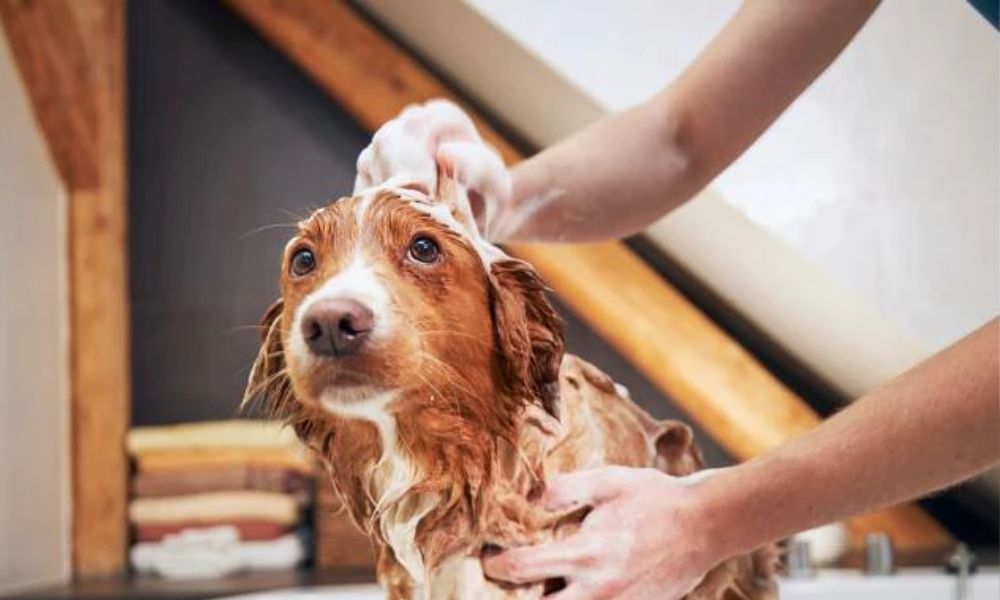Can You Use Human Shampoo on Dogs? Here’s What to Know

You love your pet. Maybe even more than some people. So when bath time rolls around, your first thought is probably to grab your favorite shampoo bottle. After all, if it makes your hair glossy and your scalp squeaky clean, surely it’ll do wonders for your dog or cat, right?
Not exactly.
Here’s a pet care trivia on what makes human shampoo different from pet-safe shampoo and why skipping that swap could save your pet from serious consequences.
PH Difference Between Humans and Pets
Human skin has a slightly acidic pH, usually hovering around 5.5, which helps maintain the skin barrier and fight off microbes. Pet skin, on the other hand, usually sits around 6.5 to 7.5, which is more neutral to mildly alkaline.
What does this mean in real life? Using a shampoo meant for your skin can disrupt your pet’s acid mantle, that delicate barrier that keeps moisture in and irritants out. Once that balance tips, your pet’s skin becomes dry, flaky, and vulnerable to bacteria and allergens. It’s like stripping the protective layer off a wall and then wondering why the paint keeps peeling.
The right pet shampoo is designed to respect your pet’s natural pH, not bulldoze through it!
Toxic Scents for Pets
We know a flower-scented shampoo makes your bathroom feel like a spa, and we love that. But your dog has a sense of smell up to 100,000 times more powerful than yours, so that "refreshing" fragrance could be overwhelming, even distressing, to them.
Pet shampoos, on the other hand, are either unscented or use subtle, pet-safe fragrances that won’t give your dog a sensory overload. Unlike humans, scent isn’t a cosmetic for animals. It's tied to emotional regulation and behavior. What are some pet product ingredients to avoid?
- Essential oils like tea tree, peppermint, eucalyptus, and more
- Fragrances and dyes
- Sulfates and parabens
These ingredients, often used in human shampoos and conditioners, can trigger allergic reactions, skin inflammation, or worse — poisoning. Remember, pets have fewer layers of skin than humans, meaning irritants reach deeper and faster. And unlike you, they don’t get to rinse and moisturize with a nice lotion afterward.
Conditioners, Coats, and Clogged Pores
Most human conditioners contain silicones, which are meant to smooth and coat hair for shine. Great for a blowout! But not so great for a double-coated Labrador.
These ingredients can cause buildup on your pet’s skin, clog pores, and interfere with their ability to regulate temperature. This is especially dangerous for breeds with thick coats or undercoats.
Pet-safe conditioners are usually water-based, lightweight, and focused on detangling and moisturizing without residue. Think aloe vera, oatmeal extracts, or coconut-derived conditioners. Gentle, functional, and nothing extra.
How to Choose a Pet-Safe Shampoo or Conditioner
Here’s what to look for when buying dog shampoo or conditioner safe for the skin. Make sure to do your research about the ingredients included in the product you’ll purchase.
- pH-balanced for pets
- Alcohol-free & soap-free
- Hypoallergenic
- Uses natural ingredients
- Free from parabens, sulfates, artificial colors, and fragrance bombs
Also, look for tear-free formulas, especially for puppies and kittens. Their eyes are even more delicate than their skin.
Still unsure? Some brands, like the Happy Life Pet Shampoo and Conditioner, make veterinarian-approved formulas, which means they’ve passed some level of scrutiny beyond marketing fluff. It’s all-natural, made with neem, with antifungal, antiviral, and antibacterial properties, madre de cacao, a natural anti-itch insect repellent, aloe vera, to soothe dry and flaky skin, coconut oil, a natural anti-viral ingredient, and more to help heal burns and keep your pet’s skin moisturized and smelling nice.
Check it out from Azius Ventures for a guaranteed clean and safe do-it-yourself pet bath.
What Happens If You've Already Used Human Shampoo on Your Pet?
If you’ve already bathed your pet with your favorite herbal essence, don’t panic! One wash won’t be catastrophic for most pets. Just watch for:
- Redness or rash
- Excessive itching or licking
- Dry or flaky skin
If symptoms persist, a gentle rinse with plain lukewarm water, followed by a switch to a pet-safe shampoo, usually gets things back on track. If you remain in doubt, a quick call to your vet is always the wisest move.
Highlights
- Human shampoo ≠ pet shampoo. Different skin, different needs.
- pH, fragrance, and ingredients all matter more than you think.
- Just because it's safe for you doesn't mean it's safe for your dog.
- Opt for shampoos designed specifically for pets.
- Be cautious of overpowering scents, hidden toxins, and human conditioner slip-ups.
Related articles:5 Ways to Get Rid of Dog Smell In Your House, How to Clean White Dog Fur Stains



